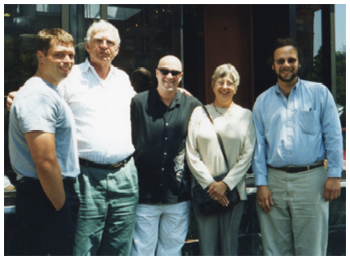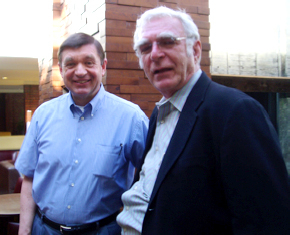In the thick of physics
"If I'm not here (at the Lab), I'm really out of it," said Becker, 74. "I'm more of a doer."
And Becker has done quite a bit during his 30-plus-year LLNL career. Born and raised in New York City, Becker is not the stereotypical New Yorker. In fact, he's quite modest when describing his work, attributing any success he's had to the plethora of excellent scientists he's had the pleasure of working with, beginning with John Fox (Becker's major professor) and including for example Brookhaven National Lab's Ernie Warburton.
Becker is an elder statesman when it comes to nuclear physics at the Laboratory. He serves as a mentor and friend to postdocs and colleagues alike.
"I can honestly say that no person (with the possible exception of my thesis adviser) has had a more profound impact on my career than John," said Lee Bernstein, who served as a postdoc and then a junior staff member and worked directly with Becker from 1994-1998. Becker also was one of the senior scientists who Bernstein did his thesis work with while at Rutgers University. "In the acknowledgements section of my thesis I said that John showed me 'the dignity in science.' "
That's where the doer part of Becker's Lab work comes in. The research he has contributed to includes: breakthrough work that provides insight into the hafnium isotope controversy; the development of the germanium radiation detector Cryo 3 for Homeland Security; measurement of the nuclear isotope thorium-229 doublet splitting; and exploration of "superdeformed" nuclei near mass 194.
Becker said his experimental work making very difficult measurements of a particular nuclear cross section -- the production of Pu-238 when a neutron interacts with Pu-239 -- in support of the Stockpile Stewardship Program is what really earned him and his LLNL and Los Alamos colleagues recognition within DOE.
"The cross section is very important to the weapons community," he said. The finding earned him and the Becker/Nelson LLNL//LANL experimental team the 2002 NNSA Defense Program Award of Excellence.
"Putting this diagnostic on a scientific footing as part of stockpile stewardship came near the end of his career at LLNL, and was truly an experimental tour-de-force," said Dennis McNabb, who met Becker as a Rutgers graduate student and continued to work with him as a postdoc.
Becker's mind moves a mile a minute when it comes to physics projects. McNabb said: "He has a habit of mentally moving around these topics very quickly, often without alerting you that he's changed topics, which has led to many amusing conversations. But somehow, over the course of a few months, you come to understand these patterns and interconnections in some sort of Zen-like way and appreciate how deep and thoughtful John is. His thoughtfulness is not only in areas of science, but extends to his personal relationships as a friend and mentor."
In fact, it is Becker's shining personality that has drawn students, colleagues and collaborators to him. His strong university ties have made him an invaluable source for bringing postdocs into the field of nuclear science. "I'm a big recruiter of people," Becker said.
"John is full of energy with new ideas in both basic and applied nuclear science," said Jolie Cizewski, a Rutgers University professor and a Becker collaborator since 1979. "He's committed to mentoring early career scientists, especially postdocs."
Former postdocs agree. "He treated everyone (including the graduate students) with a great deal of professional respect, while at the same time looking out for you to make sure you had everything you needed to do excellent work on your experiments," McNabb said. "He also had a very clear view of the potential value that the somewhat abstract work we were doing might have to society at large."
D uring his career at the Lab, Becker nurtured at least a dozen post-docs who have gone on to have distinguished careers of their own. Several stayed at LLNL and are now considered scientific leaders in their own right.
"John is an amazingly inventive and resourceful scientist with a deep knowledge of applied and basic nuclear science," Bernstein said. "Many people with this blend of natural talent and dedication can be distant and difficult to work with. However, John is not like this at all. There are a few individuals at the Lab who help to make it an attractive place for young scientists to start their career. I would put John foremost in that list."
Becker didn't start his dive into physics at LLNL. He graduated with a bachelor's degree in physics from Queens College of the City University of New York in 1957. He received his Ph.D. in physics from Florida State University, working under John Fox, in 1962. He did his postdoc stint at Brookhaven from 1962-64 and headed west to Lockheed in Palo Alto, where he worked from 1964-78. He also served as a Science Research Council senior research fellow in the Nuclear Physics Laboratory at Oxford University from 1971-72.
In 1978, former Los Alamos Director John Browne, who worked at the Laboratory at the time, hired Becker.
"John is a fantastically creative person and also very, very good at getting folks to work together on projects," said Mark Stoyer, who worked with Becker as a postdoc. "During my time here at LLNL (26 years) I've had the opportunity to work with a lot of great people -- John is definitely one of the best."
A fellow of the American Physical Society since the 1970s, Becker was recently selected as a 2010 fellow of the American Association for the Advancement of Science for a "lifetime of contributions to basic and applied nuclear physics research and technology." He also has earned numerous NNSA awards as well as Laboratory accolades for his work in stockpile stewardship.
Though officially retired in 2006, Becker still enjoys being in the thick of basic and applied nuclear physics.
"I didn't start a new life (when I retired)," he said. "LLNL physics is what I do."
-- Anne M. Stark






